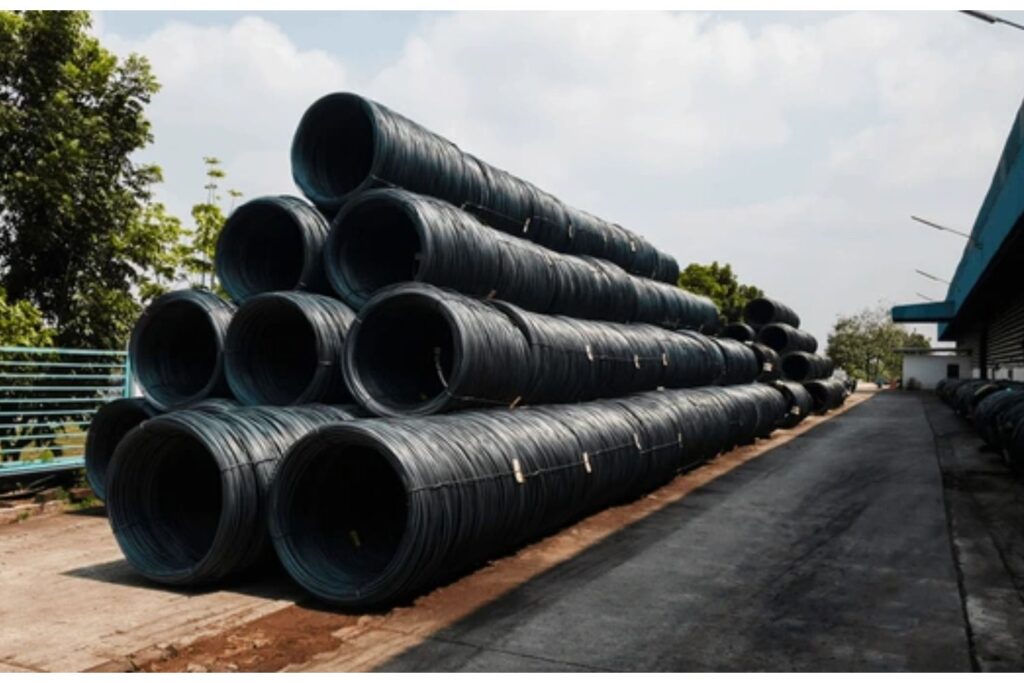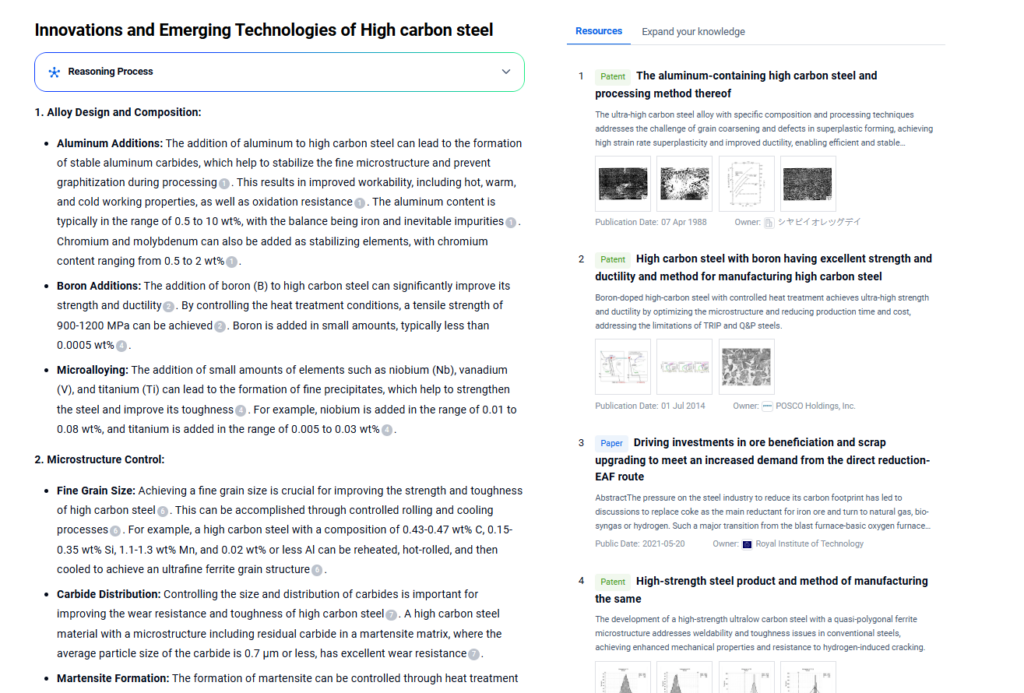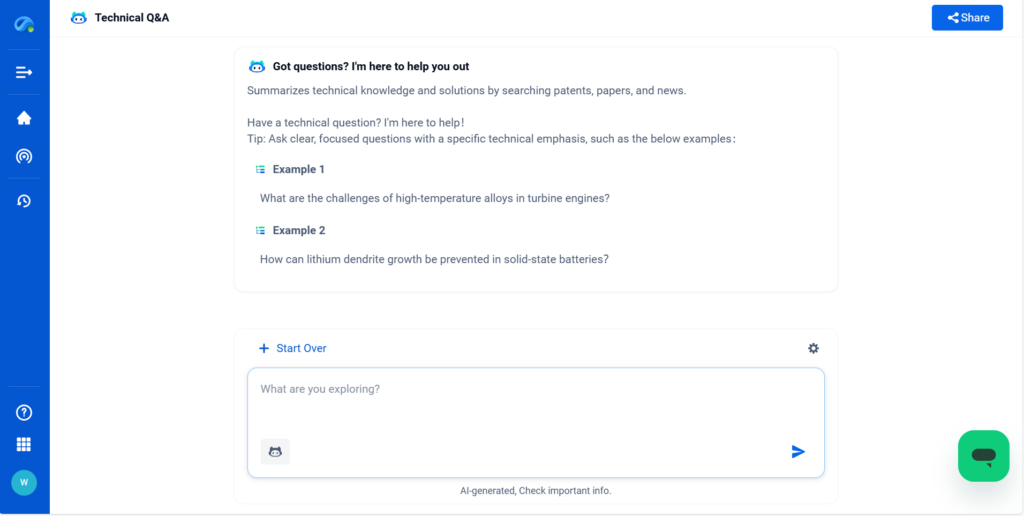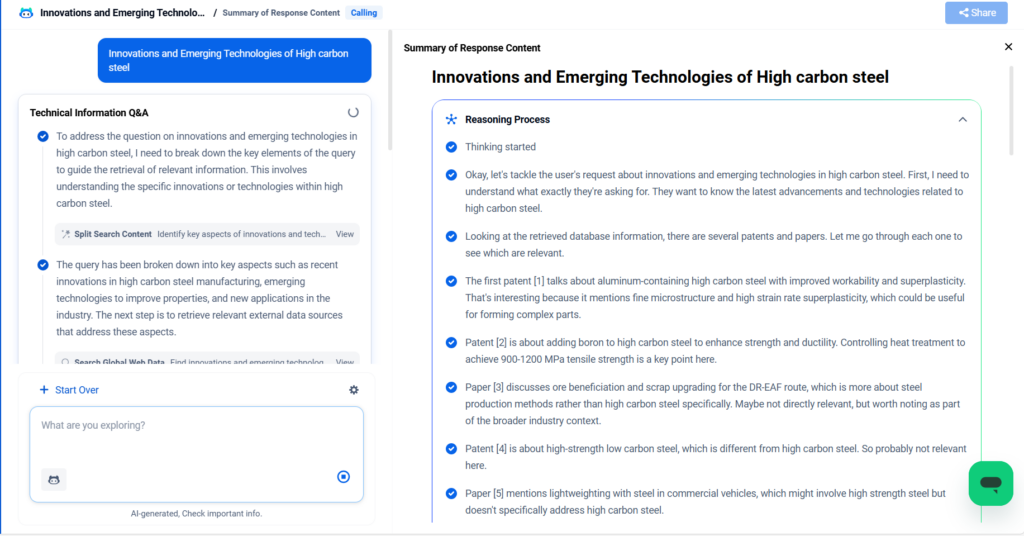
High carbon steel, defined by a carbon content typically between 0.6% and 1.0%, is one of the most valued materials in structural and tool-grade engineering. Known for its superior hardness, wear resistance, and tensile strength, it plays a critical role in applications where mechanical performance must not falter. From high-load bearing components in automotive transmissions to precision-cutting blades in industrial tooling, high carbon steel delivers robustness under extreme conditions. This blog explores its exact composition, datasheet-backed grades, performance profile, and where its adoption is rising in today’s advanced manufacturing landscape through PatSnap Eureka AI Agent.
Material Composition and Grade Data
High carbon steel is predominantly composed of:
- Carbon (C): 0.6–1.0%
- Iron (Fe): Balance
- Manganese (Mn): 0.3–0.9%
- Silicon (Si): 0.1–0.4%
- Sulfur (S) and Phosphorus (P): ≤ 0.05% (impurities)
Representative Grades and Standards
| Grade | Code | Supplier / Standard | Key Use |
|---|---|---|---|
| AISI 1095 | UNS G10950 | ASTM A682 | Springs, knives, cutting tools |
| EN C75S | 1.1248 | DIN EN 10132 | Saw blades, hand tools |
| SK5 | JIS G4401 | Hitachi Metals | Razor blades, measuring tapes |
| 1060 Steel | UNS G10600 | SAE/AISI | Swords, axes, hammer heads |
Datasheet Insight:
AISI 1095 steel, for instance, offers a Rockwell hardness of ~58 HRC post heat treatment, with a tensile strength exceeding 900 MPa, ideal for fatigue-prone environments.
Key Properties That Define High Carbon Steel
High carbon steel is defined by a trade-off between ductility and strength, leaning strongly toward the latter:
- Exceptional Hardness: Up to 65 HRC after quenching and tempering.
- High Tensile Strength: >900 MPa for hardened grades like 1095 or SK5.
- Excellent Wear Resistance: Makes it ideal for high-friction applications.
- Heat Treatability: Easily hardened and tempered to target mechanical specs.
- Low Weldability: Requires preheat and post-weld treatment due to cracking risks.
- Reduced Ductility: Brittle behavior in cold environments without proper heat treatment.
Core Applications Across Industries
High carbon steel’s superior hardness, wear resistance, and edge retention make it indispensable across multiple high-performance sectors. From manufacturing to defense, its unique mechanical attributes support critical operations where durability and reliability are non-negotiable. Below, we explore how this alloy is utilized across key industries, each leveraging its strength for specific performance outcomes.

Manufacturing & Toolmaking
High carbon steel plays a foundational role in the toolmaking and manufacturing industries due to its exceptional hardness and wear resistance after heat treatment. It is the material of choice for crafting cutting tools, chisels, taps, dies, punches, and industrial blades. And Grades such as AISI 1095 and SK5 are widely used for producing high-precision tools that require edge retention under continuous mechanical stress. Its machinability before hardening allows for complex shaping, followed by heat treatment to achieve final performance.
Automotive Engineering
In automotive applications, high carbon steel is primarily utilized for components that demand high tensile strength and surface hardness. Engine valve springs, suspension components, clutch plates, and seat mechanisms often incorporate high carbon grades like SAE 1075 due to their ability to endure cyclic loading and deformation without permanent damage. And its fatigue resistance and reliability under impact make it well-suited for high-stress mechanical parts in both passenger and commercial vehicles.
Aerospace & Defense
The aerospace and defense sectors benefit from high carbon steel’s balance of strength, rigidity, and cost-effectiveness. While not as lightweight as titanium alloys, certain applications—such as weapon parts, structural brackets, and wear-resistant fasteners—still rely on high carbon steels like 1080 and 1095. Its use in military-grade knives, impact tools, and structural subcomponents demonstrates its mechanical durability and dependable thermal performance under variable operational conditions.
Construction & Infrastructure
High carbon steel is extensively used in construction tools and structural elements that demand hardness and impact resistance. Rebar shears, masonry tools, and concrete chisels often utilize high carbon alloys, particularly where repeated contact with hard materials is involved. In some specialized bridge components or earthquake-resistant designs, its rigidity contributes to overall safety. Pre-stressed and cold-drawn wires made from high carbon steel also form part of advanced civil engineering frameworks.
Energy Sector & Mining
The mining and energy industries employ high carbon steel in drilling and excavation tools that face extreme wear. Picks, drill bits, rock crushers, and excavation teeth benefit from the material’s hardness and ability to retain cutting geometry under abrasive conditions. Additionally, in oil and gas operations, high carbon steels are sometimes used in secondary components where hardness and cost-effectiveness are critical. High manganese variants also offer a balance between work-hardening and fracture toughness.
Consumer Goods & Cutlery
High carbon steel has long been favored in the production of high-end knives, razors, hand tools, and scissors due to its edge-holding capabilities. Kitchen knife manufacturers often utilize 1095 or white steel #2 for blades that maintain sharpness through prolonged use. Although these steels may oxidize without proper care, enthusiasts and professionals value the balance of hardness, ease of sharpening, and tactile feedback they offer over stainless steel counterparts.
Comparative Advantages and Limitations
| Aspect | High Carbon Steel | Low Carbon Steel | Stainless Steel |
|---|---|---|---|
| Hardness | Excellent (post heat treatment) | Poor | Moderate |
| Weldability | Limited | Excellent | Moderate |
| Corrosion Resistance | Low (without coating) | Low | High |
| Cost | Low to Moderate | Low | High |
| Fatigue Resistance | High | Low to moderate | Moderate to high |
| Application Fit | Tooling, springs, wear components | Sheet metal, structural beams | Medical, food, decorative |
In contrast to stainless steel, high carbon steel favors strength over corrosion protection and ductility, making it better suited for static or impact-based applications rather than fluid-contact or corrosive environments.
Innovations and Emerging Technologies
Recent developments in the metallurgical refinement of high carbon steels include:
- Cryogenic Treatment: Enhances wear resistance by refining martensitic structure.
- Powder Metallurgy (PM-HCS): Used for precision blades and dies with better uniformity.
- Nano-structuring via SPD (Severe Plastic Deformation): Achieves ultra-high hardness without brittleness.
- Hybrid Coatings: Ceramic or polymer coatings (e.g., DLC) mitigate corrosion while preserving mechanical advantages.
Moreover, additive manufacturing trials using high carbon powders are ongoing for applications like custom gears and impact tooling, despite the challenges in controlling cracking during sintering or cooling.

Industry Challenges and Future Outlook
While high carbon steel remains indispensable, several engineering challenges persist:
- Brittleness: Especially in cryogenic or highly dynamic conditions
- Corrosion: Without proper coatings, it degrades quickly in humid or salty environments
- Weldability Issues: Limits its flexibility in component integration
Looking Ahead:
- Advanced thermomechanical processing is expected to make ductile high-strength variants more feasible.
- Cross-alloying with elements like vanadium or niobium is being explored to fine-tune fatigue behavior.
- Recycling efficiency remains an open area for sustainability-focused metallurgy, especially in post-industrial tool waste.
Conclusion: Engineering Strength with Precision
High carbon steel is a cornerstone of mechanical performance across tooling, transportation, and manufacturing. Moreover, its high hardness and durability make it invaluable for static and high-load scenarios, despite inherent challenges in weldability and corrosion. Emerging surface treatment and alloying innovations continue to expand its potential. For R&D teams evaluating material trade-offs or tracking technical evolution, tools like PatSnap Eureka provide real-time patent landscapes, performance benchmarking, and supplier insights.
FAQs
While technically possible using powder-bed fusion or binder jetting, it poses significant cracking risks due to high carbon content. And Research is ongoing.
1095 offers higher hardness and edge retention, though it rusts more easily if not maintained or coated.
Yes, but careful segregation is needed to avoid contaminating lower-carbon steel recycling streams.
SK5 has higher carbon (~0.85%) and is used for precise tools, while 1060 (~0.6%) is tougher and used in impact applications like hammer.
Want to uncover patent trends, supplier dynamics, or R&D breakthroughs in high carbon steel technologies?
👉 Explore deeper insights using PatSnap Eureka AI Agent—your AI-powered platform for materials innovation, technical benchmarking, and competitive landscape analysis. From advanced metallurgy to heat-treatment optimization, Eureka helps engineers and researchers stay ahead in high-performance steel development.




